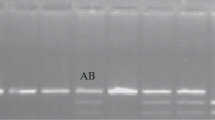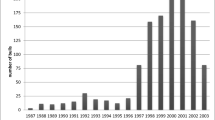Summary
Digestion of genomic DNA with the restriction endonuclease Avail disclosed a probable insertion deletion of approximately 200 base pairs (bp) near the prolactin gene. Two alleles were apparent as three distinct hybridization patterns. These alleles were statistically associated with quantitative trait loci among sons of one elite Holstein sire family. The favorable genotype was correlated with the presence of a 1.15-kb hybridization band inherited from the sire when genomic DNA was probed with a full-length cDNA for prolactin. Pedigree estimates of genetic merit among genotypes were similar, differing by only 19.3 kg for milk in ancestor merit. Comparisons of genetic estimates for quantitative yield traits in offspring of this heterozygous sire showed significant (P<0.05) differences between homozygous genotypes for predicted difference milk (PDM), predicted difference dollars (PD$), cheese yield dollars, and protein dollars. The estimated differences between homozygous genotypes for USDA Transmitting Abilities of PDM, PD$, Cheese Yield $ and Protein $ were 282.93 kg, $74.35, $48.58 and $53.67, respectively. However, the estimated breeding values from progeny ranged over 900 kg in transmitting ability for milk. Frequency of the favorable marker allele was estimated to be 0.231 in the elite cow population used as dams of sons. These results demonstrate the potential of molecular biological techniques to discriminate between individuals within a family and to predict breeding values for selection schemes.
Similar content being viewed by others
References
Beckmann JS, Soller M (1983) Restriction fragment length polymorphisms in genetic improvement: methodologies, mapping and costs. Theor Appl Genet 67:35–43
Beckmann JS, Soller M (1988) Detection of linkage between marker loci and loci affecting quantitative traits in crosses between segregating populations. Theor Appl Genet 76:228–236
Camper SA, Luck DN, Yao Y, Woychik RP, Goodwin RG, Lyons RH, Rottman FM (1984) Characterization of the bovine prolactin gene. DNA 3:237–249
Cowan CM, Dentine MR, Ax RL, Schuler LA (1989) Restriction fragment length polymorphisms associated with growth hormone and prolactin genes in Holstein bulls: evidence for a novel growth hormone allele. Anim Genet 20:157–165
Dentine MR, Cowan CM (1990) An analytical model for the estimation of chromosome substitution effects in the offspring of individuals heterozygous at a segregating marker locus. Theor Appl Genet (in press)
Famula TR (1986) Identifying single genes of large effect in quantitative traits using best linear unbiased prediction. J Anim Sci 63:68–76
Gavora JS, Spencer JL (1983) Breeding for immune responsiveness and disease resistance. Anim Blood Groups Biochem Genet 14:159–180
Geldermann H (1975) Investigations on inheritance of quantitative characters in animals by gene markers. 1. Methods. Theor Appl Genet 46:319–330
Geldermann H, Pieper U, Roth B (1985) Effects of marked chromosome sections on milk performance in cattle. Theor Appl Genet 70:138–146
Henderson CR (1976) A simple method for computing the inverse of a numerator relationship matrix used in prediction of breeding values. Biometrics 32:69–84
Hoeschele I (1988a) Genetic evaluation with data presenting evidence of mixed major gene and polygenic inheritance. Theor Appl Genet 76:81–92
Hoeschele I (1988b) Statistical techniques for detection of major genes in animal breeding data. Theor Appl Genet 76:311–319
Kluge R, Geldermann H (1982) Effects of marked chromosome sections on quantitative traits in the mouse. Theor Appl Genet 62:1–4
Rigby PWJ, Dieckmann M, Rhodes C, Berg P (1977) Labelling deoxyribonucleic acid to high specific activity in vitro by nick translation with DNA polymerase I. J Mol Biol 113:237–251
Roberts RC, Smith C (1982) Genes with large effects theoretical aspects in livestock breeding. In: Proc 2nd World Congr Genet Appl Livestock Prod, vol VI. Publicaciones Agrarias, Madrid, pp 420–438
Salmon RK, Berg RT, Yeh FC, Hodgetts RB (1988) Identification of a variant growth hormone haplotype in mice selected for high body weight. Genet Res Camb 52:7–15
Sasavage NL, Nilson JH, Horowitz S, Rottman FM (1982) Nucleotide sequence of bovine prolactin messenger RNA. Evidence for sequence polymorphism. J Biol Chem 257:678–681
Smith C, Simpson SP (1986) The use of genetic polymorphisms in livestock improvement. J Anim Breed Genet 103:205–217
Soller M, Beckmann JS (1988) Genomic genetics and the utilization for breeding purposes of genetic variation between populations. In: Proc 2nd Int Conf Quant Genet. Sinauer Associates, Sunderland/MA, pp 161–188
Southern EM (1975) Detection of specific sequences among DNA fragments separated by gel electrophoresis. J Mol Biol 98:503–517
Stam P (1986) The use of marker loci in selection for quantitative characters. In: Smith C, King JWB, McKay JC (eds) Exploiting new technologies in animal breeding. Genetic developments. Oxford University Press, pp 170–182
Tanksley SD, Medina-Filho H, Rick CM (1982) Use of naturally occurring enzyme variation to detect and map genes controlling quantitative traits in an interspecific backcross of tomato. Heredity 49:11–25
Watkins PC (1988) Restriction fragment length polymorphism (RFLP): applications in human chromosome mapping and genetic disease research. Biotechniques 6:310–323
Wiggans GR, Norman HD, Powell RL (1984) Changes in genetic evaluation procedures for January 1984. Dairy Herd Improv Lett 60:1–10
Author information
Authors and Affiliations
Additional information
Communicated by E. J. Eisen
Rights and permissions
About this article
Cite this article
Cowan, C.M., Dentine, M.R., Ax, R.L. et al. Structural variation around prolactin gene linked to quantitative traits in an elite Holstein sire family. Theoret. Appl. Genetics 79, 577–582 (1990). https://doi.org/10.1007/BF00226868
Received:
Accepted:
Issue Date:
DOI: https://doi.org/10.1007/BF00226868




